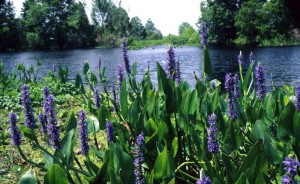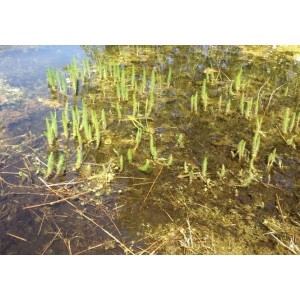Bank plants
Home " Bank plants
Bank plants
These types of plants are indispensable for wildlife in and around a pond. From an aesthetic point of view, there is of course also a lot to be said for bank plants; a number of species are an asset to your pond due to their beautiful inflorescence. Pikeweed is one example. The pretty purple flowers are a feast for the eyes.
In addition to the indigenous Jerusalem artichoke the oriental variety is also available. Don't let the name fool you too much; this species does fine in Dutch ponds and survives cold winters without any problems.

Pikeweed. The plant with a beautiful inflorescence.
There are very many species of riparian plants, each with their particularities. As a production material for chairs (rush) or roofs (reed), host plant for special butterflies, for example, or with the lovely scents and beautiful colours, edible, medicinal and beneficial, detoxifying, disinfecting and purifying, these are just a few of the specific properties that can apply to riparian plants.
Divergent, then, but they also have something in common. Basically, riparian plants are plants that grow along the water. They are often moisture-loving plants. Not every riparian plant is a helophyte and not every moisture-loving plant is a riparian plant. Nevertheless, many plants are used around ponds that are not true riparian plants but actually belong in moist forests or in wet grasslands. Of course, this is allowed and possible. Nature selects anyway; if it doesn't fit in, it won't grow. However, this is not always fun for pond owners!
Note! Not all riparian plants are moisture-loving.
Indeed, some plants are not even largely moisture-loving but are found along banks of ponds. An example is Common Goldenrod, this is based on a name confusion with Late Goldenrod, which is common along rivers in floodplains. Among non-native plants, this is even more common. Mammoth leaf from Brazil (Gunnera Manicata) is a giant riparian plant that is indistinguishable to many from Mammoth leaf from chilli (Gunnera Tinctoria) that usually grows in rocky regions.
However, a trusted sales address and knowledgeable advice can help pond owners avoid these mis-purchases.
Tip!
Dutch nature conservation is labelled as gardening but then the reverse is also true. Therefore, place rare native species such as Reed Orchid, Marsh Wasp Orchid, Lapwing, Waternut, White Watercress, Water Gentian, etc. in or along your water feature and contribute to species conservation while enjoying Dutch flora. Native species are not more expensive than exotic and tropical species but they do better in our climate and often look more natural than their foreign counterparts. This makes the water feature appear less crowded and radiate more tranquillity.
Buy riparian plants?

Shoreline plants are for sale through De Vijvermeester's webshop. Here you can find beautiful bunches of high-quality plants.
